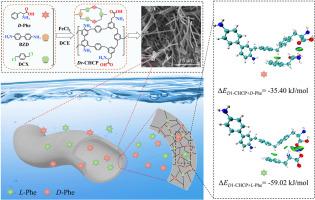Nanotubular chiral hyper-crosslinked polymers with ultrafast adsorption rate for enantioselective separation
IF 4.7
3区 材料科学
Q1 CHEMISTRY, APPLIED
引用次数: 0
Abstract
The separation of racemic mixtures remains a great challenge due to the similar physicochemical properties of enantiomers in achiral environment. In this work, three novel chiral hyper-crosslinked polymers (CHCPs), i.e., D0-CHCP, D1-CHCP and D2-CHCP, were synthesized by tuning the D-phenylalanine (D-Phe)/benzidine (BZD) ratios. Results show that all three CHCPs exhibit typically hollow cylindrical nanotube. D1-CHCP and D2-CHCP achieve ultrafast enantioselective adsorption of D- and L-Phe within 2 min, attributed to ultrathin-walled nanotubes having hierarchically porous structures. More importantly, D2-CHCP has a high enantiomeric excess (e.e.) value of up to 56.01 %, likely due to the cooperative interplay between D0-CHCP and the implanted chiral recognition unit, as evidenced by the control experiment that D0-CHCP exhibits chiral separation capability to some extent. In addition, these CHCPs display excellent recyclability and generality for chiral small-molecule drugs. These findings demonstrate that nanotubular CHCPs with ultrathin wall thickness and hierarchically porous structures possess both superior enantioselectivity and ultrafast adsorption rates, thus offering significant potential for practical applications in enantioselective adsorption separation.

具有超快吸附速率的纳米管手性超交联聚合物用于对映选择性分离
由于对映体在非手性环境中具有相似的物理化学性质,因此外消旋混合物的分离仍然是一个很大的挑战。本文通过调节d -苯丙氨酸(D-Phe)/联苯胺(BZD)的比例,合成了3种新型手性超交联聚合物(chcp),即D0-CHCP、D1-CHCP和D2-CHCP。结果表明,这三种CHCPs均表现为典型的空心圆柱形纳米管。D1-CHCP和D2-CHCP由于具有分层多孔结构的超薄壁纳米管,可以在2分钟内实现对D-和l -苯丙氨酸的超快速对映选择性吸附。更重要的是,D2-CHCP的对映体过量(e.e)值高达56.01%,这可能是由于D0-CHCP与植入的手性识别单元之间的协同相互作用,对照实验表明,D0-CHCP具有一定的手性分离能力。此外,这些CHCPs对手性小分子药物具有良好的可回收性和通用性。这些发现表明,具有超薄壁厚和分层多孔结构的纳米管CHCPs具有优异的对映选择性和超快的吸附速率,因此在对映选择性吸附分离方面具有重要的实际应用潜力。
本文章由计算机程序翻译,如有差异,请以英文原文为准。
求助全文
约1分钟内获得全文
求助全文
来源期刊

Microporous and Mesoporous Materials
化学-材料科学:综合
CiteScore
10.70
自引率
5.80%
发文量
649
审稿时长
26 days
期刊介绍:
Microporous and Mesoporous Materials covers novel and significant aspects of porous solids classified as either microporous (pore size up to 2 nm) or mesoporous (pore size 2 to 50 nm). The porosity should have a specific impact on the material properties or application. Typical examples are zeolites and zeolite-like materials, pillared materials, clathrasils and clathrates, carbon molecular sieves, ordered mesoporous materials, organic/inorganic porous hybrid materials, or porous metal oxides. Both natural and synthetic porous materials are within the scope of the journal.
Topics which are particularly of interest include:
All aspects of natural microporous and mesoporous solids
The synthesis of crystalline or amorphous porous materials
The physico-chemical characterization of microporous and mesoporous solids, especially spectroscopic and microscopic
The modification of microporous and mesoporous solids, for example by ion exchange or solid-state reactions
All topics related to diffusion of mobile species in the pores of microporous and mesoporous materials
Adsorption (and other separation techniques) using microporous or mesoporous adsorbents
Catalysis by microporous and mesoporous materials
Host/guest interactions
Theoretical chemistry and modelling of host/guest interactions
All topics related to the application of microporous and mesoporous materials in industrial catalysis, separation technology, environmental protection, electrochemistry, membranes, sensors, optical devices, etc.
 求助内容:
求助内容: 应助结果提醒方式:
应助结果提醒方式:


